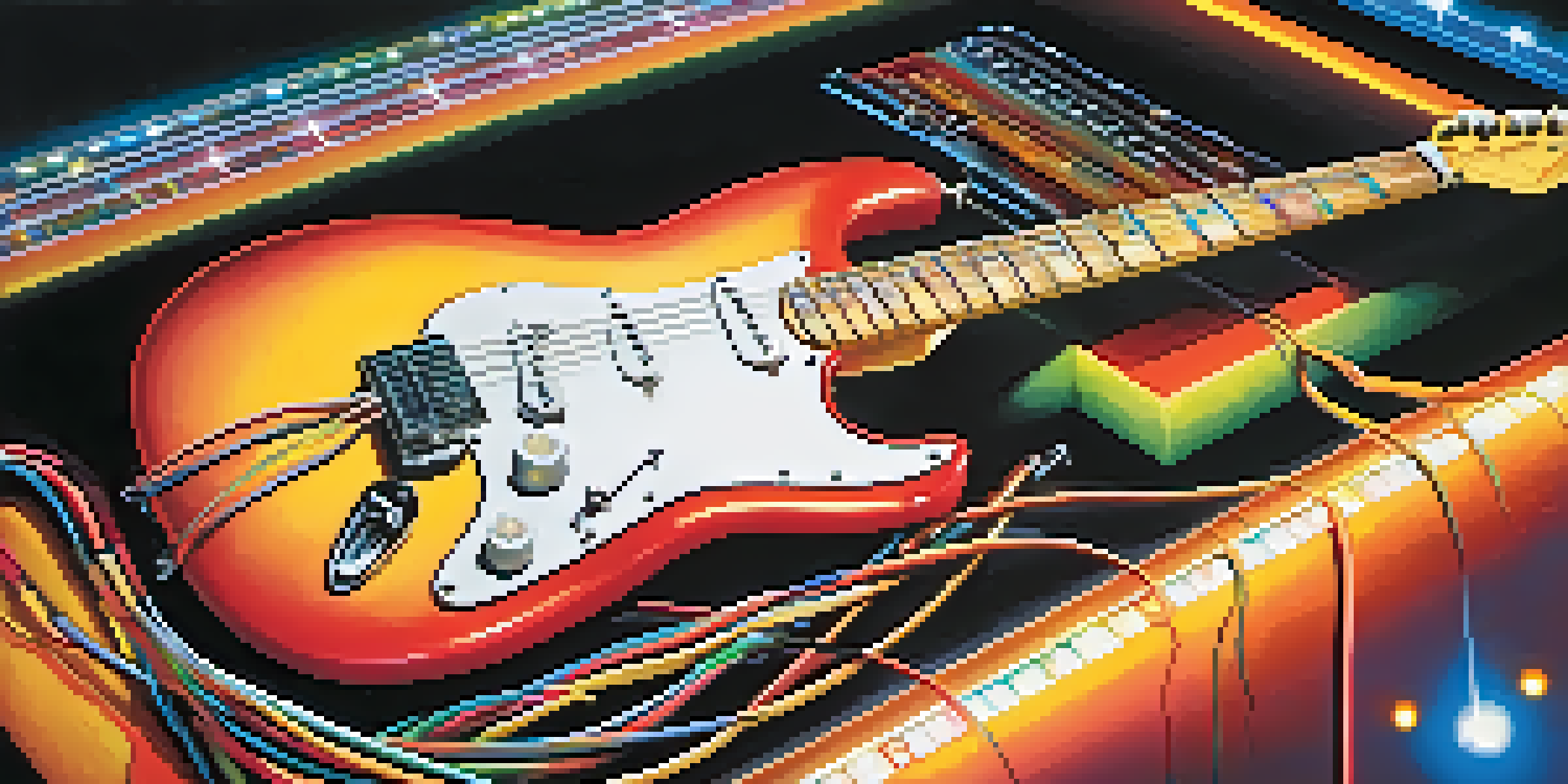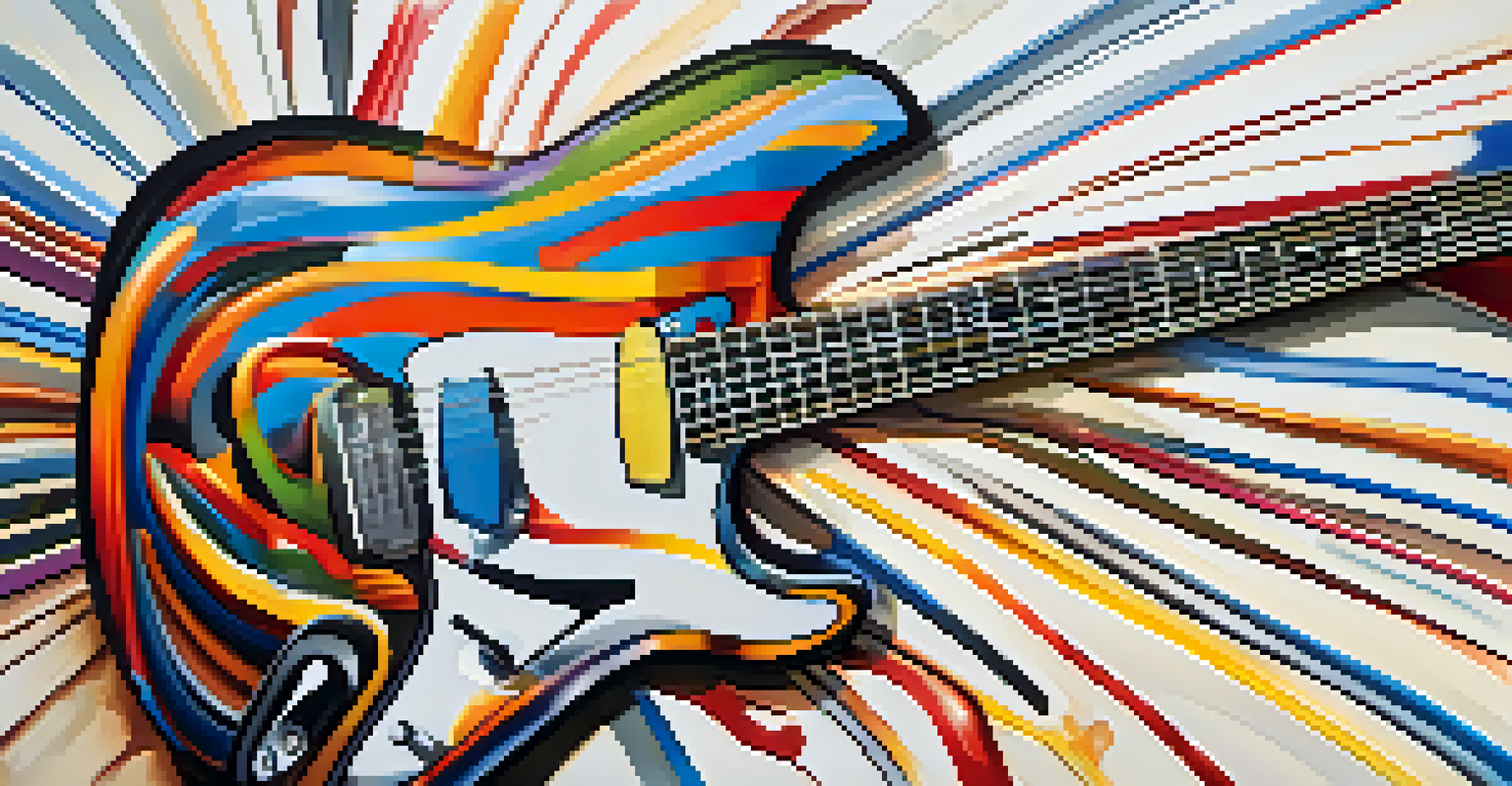Funk Guitar Techniques: Styles for Groovy Rhythms

Understanding the Funk Style: A Rhythmic Foundation
Funk music is all about rhythm, and understanding its essence is crucial for any guitarist. It's characterized by its syncopated beats and strong emphasis on the off-beat, giving it that unmistakable groove. Think of funk as a conversation where every note has a purpose and a place, contributing to the overall dialogue of the music.
Funk is the music of the people; it’s the sound of freedom and joy, of life itself.
At its core, funk guitar relies on a tight, rhythmic approach, often using muted strums and staccato notes to create a punchy sound. This technique not only adds energy but also allows for a dynamic interplay with other instruments in the band. Imagine a drummer laying down a beat while you accentuate the rhythm with your guitar; that's the beauty of funk.
To fully grasp the funk style, listen to iconic artists like James Brown or George Clinton. Their music showcases how rhythm and melody can intertwine to create a vibrant soundscape, encouraging you to explore your own rhythmic patterns and find your unique voice within this genre.
Essential Techniques: Chords and Voicings
Funk guitar often utilizes unique chord voicings that contribute to its signature sound. Instead of traditional full chords, funk players lean towards shorter, more percussive chord shapes, like barre chords and triads. This not only makes the sound cleaner but also helps to maintain the rhythmic feel that is so vital in funk.

One popular voicing is the dominant 7th chord, which adds a jazzy flavor to your playing. By incorporating these chords into your progressions, you can create that funky vibe that invites listeners to move and groove. Try experimenting with different voicings to see how they affect your rhythm and overall sound.
Funk's Rhythmic Essence
Funk music thrives on syncopated beats and rhythmic interplay, making every note purposeful in the overall groove.
Don’t forget about the importance of dead notes, which are muted strums that fill out the rhythm without adding pitch. They help create a more percussive sound, working alongside your chord progressions to enhance the funkiness of your playing.
The Art of Muting: Keeping It Tight
Muting is a fundamental technique in funk guitar that helps maintain a clean and focused sound. By lightly resting your palm on the strings near the bridge, you can create a sharp, staccato effect that’s essential for the genre. This technique allows you to emphasize the rhythm while keeping unwanted noise at bay.
The groove is the heartbeat of the music, and funk is all about feeling that beat.
Additionally, you can use your fingers to mute strings while playing, creating a dynamic interplay between sound and silence. This contrast is vital in funk, as it adds layers to your rhythm and keeps the groove engaging for the listener. Think of muting as a way to control the conversation of your music; it highlights what you want to say while silencing the distractions.
Practicing this technique with various strumming patterns can help solidify your understanding of funk rhythms. Start slow and gradually increase your speed as you become more comfortable with the muted strums, allowing you to lock in with the groove effortlessly.
Groove-Based Rhythms: Syncopation Explained
Syncopation is a key element in creating the infectious grooves found in funk music. It involves placing emphasis on unexpected beats or off-beats, which adds a playful twist to your rhythm. This technique can make your playing feel more alive and engaging, inviting listeners to get up and dance.
To practice syncopation, try clapping or tapping out different rhythmic patterns before applying them to your guitar. This approach helps you internalize the groove and gives you a better sense of timing. Once you feel comfortable, start incorporating those patterns into your playing, experimenting with both strumming and picking techniques.
Unique Chords and Techniques
Funk guitar often employs shorter, percussive chord voicings and techniques like muting to maintain a tight, energetic sound.
Listening to classic funk tracks can provide inspiration and insight into effective syncopation. Pay attention to how different instruments interact and how their rhythms complement each other, allowing you to gain a deeper understanding of this essential aspect of funk.
Slap and Pop: Adding Percussive Elements
Slap and pop techniques are hallmarks of funk guitar, adding a percussive flair that makes your playing stand out. The slap technique involves striking the string with your thumb, while the pop is executed by pulling the string away from the fretboard and letting it snap back. Together, they create a dynamic sound that’s both rhythmic and melodic.
To get started, practice these techniques slowly, focusing on your thumb's precision and your finger's agility. As you become more comfortable with the motions, you can gradually increase your speed and incorporate them into your funk grooves. This will not only enhance your sound but also give you a unique way to express yourself musically.
Many funk legends, like Larry Graham and Prince, have mastered these techniques, showcasing how they can elevate a performance. By incorporating slap and pop into your playing, you can create a signature sound that captures the essence of funk.
Using Effects: Shaping Your Funk Sound
Effects pedals can play a significant role in shaping your funk guitar sound, offering a variety of tones to explore. Common effects used in funk include wah, chorus, and overdrive, each adding a unique character to your playing. For instance, a wah pedal can help create a vocal-like quality, enhancing the expressiveness of your riffs.
When experimenting with effects, remember that subtlety is key. Funk often thrives on clarity and precision, so it’s essential to use effects that complement your playing without overwhelming it. Try layering different effects to find your signature sound that aligns with your personal style.
Incorporating Effects
Effects pedals, when used subtly, can enhance the clarity and expressiveness of your funk guitar sound, allowing for unique sonic exploration.
Listening to funk greats and analyzing their use of effects can provide valuable insights. Pay attention to how they incorporate these sounds into their music, and don't hesitate to incorporate those ideas into your own playing to discover new sonic possibilities.
Putting It All Together: Creating Your Funk Groove
Now that you've explored various funk techniques, it's time to combine them into your own unique groove. Begin by selecting a basic chord progression and experiment with different strumming patterns, incorporating muted notes and syncopation as you go. This foundation will serve as the backbone of your funk composition.
Next, integrate slap and pop techniques to add a percussive element, making your groove even more engaging. Remember to play around with effects to find the right sound that complements your style, creating a rich texture that draws listeners in. Don't shy away from improvisation; it's a key component of funk music.

Finally, practice with a metronome or along with your favorite funk tracks to fine-tune your timing and rhythm. As you develop your groove, keep an open mind and be willing to experiment, allowing your creativity to flourish and your personal funk style to emerge.